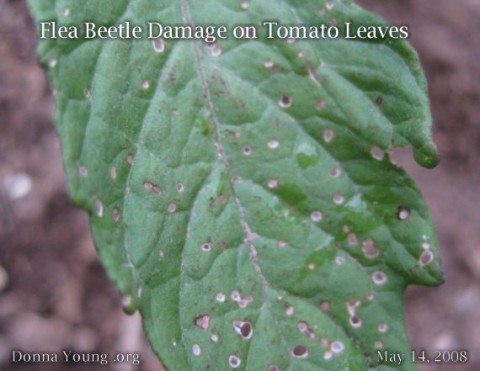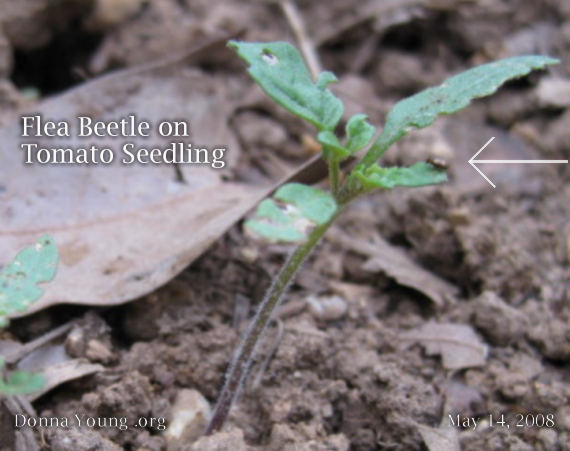Aphids and flea beetles are two garden pests that affect vegetables as soon in the season as possible for a bug. They are two of the earliest pests.
Aphids
If you see ants on your plants, then look for aphids. Ants tend to aphids because aphids secret honey dew, a substance that ants like to eat. Aphids weaken plants and spread diseases. If the honey dew that they produce is not gathered, that will attract mildew. If your garden is small like mine, a simple way to control aphid population and damage is by spraying off the affected plants every day or so. If you have it, a soapy spray suitable for plants will kill the aphids by suffocation.
The image below shows a couple of aphids on a tomato plant. These aphids are red and on the plant stems. Aphids are several colors – green, yellow, etc, and they are more often on the underside of leaves. To check for aphids, look on the underside of leaves. They can be washed off, sprayed with a plant-safe soapy spray, or squished.

Flea Beetles
Flea beetles weaken or kill young plants by eating holes in the leaves and stems. They also spread some plant diseases. They are small dark beetles that jump away when they see you. They start feeding on young plants or seedlings as soon as the bugs find them. Flea beetles eat tomatoes, peppers, potatoes, beets, cabbage, corn, and related crops.
This image shows flea beetle damage.

The image below shows a flea beetle on a tomato seedling.

In my garden, flea beetles appear every year. Last year, I walked through my garden at least twice a day to scare them off the plants. Some days, I sprayed the plant leaves with water. That was all that I did. If I had cabbages, I would cover them with a floating row cover as soon as the plants or seeds are planted. One spring I used Large jugs to cover young plants – see https://donnayoung.org/blog/life/garden/jugs-in-the-garden/
Happy Gardening!




I have never seen a Flea Beetle.
We do have aphids, but so far not in the garden. 🙂 We do have some leaf miners. I don’t know what to do about those yet. I’ll have to search.
That is good information, Donna.
I had no idea that aphids came in different colors as I’ve only seen the greens ones up here. I’ll be watching more carefully for these bugs once I get the plants planted in my containers, hopefully nextweek.
Applie, from an organic position, there is not a lot that can be done about leaf miners. The book that I have recommends keeping the ground cultivated (weed free) around the plants. It also mentions naturally occurring parasites.
Elaine I hope you can plant soon. 🙂
I’ll be getting my pools this weekend so that I can clean and disinfect them as well as the containers that I have and plan to buy. Then hopefully on Monday, if we don’t get rain (if we do that’ll be good and I’ll do this in the garage) I’ll load up the pools and containers with some good soil that I still need to purchase.
Then Monday or Tuesday I’ll get to buying the plants to put in the good soil.
Donna,
First off, I’d like to thank you for all the hard work you share with us. I’ve used your site for years and don’t think I’ve taken the time to thank you. Shame on me! Secondly, I read this blog post a few days ago, then ran across this info from Golden Harvest Organics at http://www.ghorganics.com/page2.html and thought of you and your flea beetle and aphid problems. I wonder if catnip would help.
CATNIP: Deters flea beetles, aphids, Japanese beetles, squash bugs, ants and weevils. We have found it repels mice quite well: mice were wreaking havoc in our outbuildings, we spread sprigs of mint throughout and the mice split! Use sprigs of mint anywhere in the house you want deter mice and ants. Smells good and very safe.
Thank you Barbie. It happens that I’ve started some catnip plants this year. If the catnip plants grow well, I can try this next year. 🙂